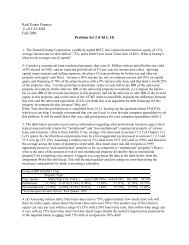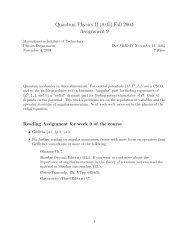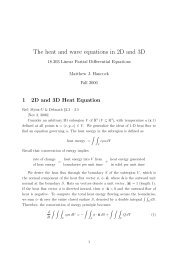Chapter 1 Galaxies: dynamics, potential theory, and equilibria
Chapter 1 Galaxies: dynamics, potential theory, and equilibria
Chapter 1 Galaxies: dynamics, potential theory, and equilibria
You also want an ePaper? Increase the reach of your titles
YUMPU automatically turns print PDFs into web optimized ePapers that Google loves.
<strong>Chapter</strong> 1<strong>Galaxies</strong>: <strong>dynamics</strong>, <strong>potential</strong> <strong>theory</strong>, <strong>and</strong><strong>equilibria</strong>1.1 Dynamics of scatteringA natural way to begin is to ask the seemingly naive question “what is a galaxy?” The straightforwardanswer is that a galaxy is a system of stars <strong>and</strong> gas, like the Milky Way (the word galaxy comesfrom the Greek for “milk”). Prior to the last century, the Milky Way was not just the only knowngalaxy, but was thought to constitute the entire Universe. In 1926, Edwin Hubble showed thatthe Andromeda nebula was actually a separate galaxy, spanning 3 o in the sky, another blow to ouranthropocentric view of the Universe (if one was needed). The Earth is not the center of the SolarSystem, the Solar System is not the center of the Milky Way, <strong>and</strong> the Milky Way is just one ofbillions (<strong>and</strong> billions) of galaxies in the Universe.Just as stars are held up by internal gas pressure, galaxies also have internal energy that preventsgravitational collapse, held in equilibrium by the virial theorem (e.g. Hansen <strong>and</strong> Kawaler 2004),2T + U = 0, (1.1)where T is the internal kinetic energy of the particles (stars) <strong>and</strong> U is the negative gravitational<strong>potential</strong> energy. Like any self-gravitating system, the <strong>potential</strong> energy, up to constants of orderunity, is given byGM 2U − , (1.2)Rwhere M <strong>and</strong> R are the mass <strong>and</strong> characteristic size of the system <strong>and</strong> G is Newton’s gravitationalconstant 1 . The kinetic energy is given by1T = M v 2 , (1.3)21 Although G is known to relatively poor accuracy in cgs units, in combination with the solar mass GM is knownquite well. We can specify G in solar mass units: G = 4.30091851 × 10 −3 M −1 (km/s) 2 pc. This is very useful givenastronomers’ habit of quoting masses in terms of M <strong>and</strong> distances in terms of parsecs.3
4 CHAPTER 1. GALAXIES: DYNAMICS, POTENTIAL THEORY, AND EQUILIBRIAµxx + b 22bmFigure 1.1: A star of mass µ travelling with velocity v passes a second star, with mass m at a distanceof closest approach (impact parameter) b.Δ bwhere v 2 is the average squared velocity for a particle in the system. The gravitational <strong>potential</strong> isthen of orderΛ GM v 2 . (1.4)RFor a typical galaxy we have:radius R 10kpcdensity δ 0.1M ∞ /pc 3 <strong>and</strong>,N stars 10 11 .The “thermal” velocity for individual stars within the galaxy is then v 210 km/s.Unlike the interiors of stars, where the mean free path (mfp) of particles is much shorter thanthe size of the star (mfp 1µm R), the mean free path of a star within a galaxy is much largerthan the size of the galaxy, suggesting that the average star cannot be expected to scatter off anotherstar during an orbit or even during its lifetime. How do we quantify scattering interactions? For astar with mass µ moving along a trajectory x = vt with impact parameter b (the distance of closestapproach if there were no deflection; see Fig. 1.1) relative to another star with mass m, the changein the component of velocity perpendicular to the direction of travel, Ωv is given by→Ωv =→F → Ωt Gmb= Ωt. (1.5)µ (x 2 + b 2 ) 3/2Assuming a constant speed v during the interaction, this change in perpendicular velocity can beintegrated over time, giving ≈ F Gm ≈→ dt GmΩv → = dt = = 2 . (1.6)−≈ µ b 2 ⎡ 2 3/2−≈ vt bv1 +bWe call a scattering “strong” if Ωv → = v, so b strong = 2Gm/v 2 . The strong scattering cross section εis therefore⎞ ⎢ 2Gm 24ψε = ψb 2 strong = ψ N2 R2 , (1.7)v2
1.1. DYNAMICS OF SCATTERING5where we have used the virial theorem to get v 2 GmN/R. We now want to see how often a starmight actually experience a strong encounter with another star. For low number densities n (anexcellent assumption for galaxies), the probability of a strong scattering encounter during a singleorbital crossing is given by⎩probability of a ⎜⎦ N 4ψ 3strong encounter nεR = R2⎪ 4ψR · · R = , (1.8)3 N 2 Nin one crossing 3a very small number for galaxies with N 10 11 ! So we can safely say that strong scattering doesnot play a very important role in the orbits of stars within the galaxy.We must nonetheless consider the cumulative effects of weak scattering from long-range gravitationalinteractions. Treating the encounters as a collection of steps in a r<strong>and</strong>om walk, we find (Ωv ) total = (Ωv i ) 2 (1.9)→Integrating over all possible impact parameters, we find that over a time Ωt, the accumulated perpendicularvelocity is given byi→(Ωv i ) 2 =i→ ≈ ⎞ ⎢ 2Gm 22ψvΩt bdb n = Ωt 8ψGm2 n ≈ db . (1.10)0bv v 0 bvolume elementIn order to get a finite value for the integral, we must impose physical bounds on b. The upper limitis the size of the galaxy. The lower limit is the impact parameter at which a collision is judged to bestrong. Taking b min = Gm/v 2 <strong>and</strong> b max = R, the integral can be evaluated as bmax db Rv2= ln = ln ln N 25, (1.11)bGmb minwhere we again use the virial theorem to substitute R/Gm N/v 2 .For a system of stars in a galaxy (or globular cluster or any collisionless, gravitationally boundsystem), we can define a relaxation time for which the accumulated perpendicular velocity is comparableto the average velocity: (Ωv →) tot v. Combining equations (1.9, 1.10, <strong>and</strong> 1.11), we seethat3v 1t relax . (1.12)8ψG 2 nm 2 ln The number of orbits needed for the system to “relax” is given by3t relax v 1 v v 4 R 2 4 ψ3Nt orbit 8ψG2 nm 2 ln R 8ψG 2 N m2 ln 6 ln N , (1.13)so it seems that weak scattering is also relatively insignificant for calculating orbits within galaxies.Evidently we must think of a galaxy not as a large collection of scatterers, but rather as a gravitationalfield that is created by <strong>and</strong> interacts with the matter in the galaxy.
















